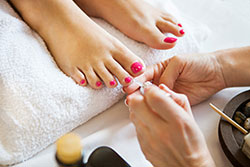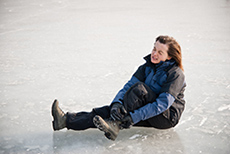|
|
 |
Dr. Robert D. Weaver
Dr. Jennifer Zienkowski-Zubel
Pedicure Do's and Dont's
Get Your Feet Ready For Spring Break
Icy Conditions Cause Falls and Broken Ankles
July 2017
Whether you like to get a pedicure in the nail salon or perform your own pedicure at home, please follow these easy Dos and Don'ts provided by the American Podiatric Medical Association to keep your feet looking and feeling their best.

Dos
- If you have diabetes or poor circulation in your feet, please contact our office, 440-442-3113, for a recommendation on a customized pedicure that you and/or your salon can follow for optimal foot health.
- Schedule your pedicure first thing in the morning. Salon foot baths are typically cleanest earlier in the day. If you're not a morning person, make sure that the salon filters and cleans the foot bath between clients.
- Bring your own pedicure utensils to the salon. Bacteria and fungus can move easily from one person to the next if the salon doesn't use proper sterilization techniques.
- When eliminating thick, dead skin build-up, also known as calluses, on the heel, ball and sides of the feet, use a pumice stone, foot file or exfoliating scrub. Soak feet in warm water for at least five minutes, then use the stone, scrub, or foot file to gently smooth calluses and other rough patches.
- When trimming nails, use a toenail clipper with a straight edge to ensure your toenail is cut straight across. Other tools like manicure scissors or fingernail clippers increase the risk of ingrown toenails because of their small, curved shape. Please contact our office for an appointment if you have a tendency to develop ingrown toenails.
- To smooth nail edges, use an emery board. File lightly in one direction without using too much pressure, being sure not to scrape the nail's surface.
- Gently run a wooden or rubber manicure stick under your nails to keep them clean. This helps remove the dirt and build-up you may or may not be able to see.
- Maintain the proper moisture balance of the skin on your feet by applying emollient-enriched moisturizer to keep soles soft.
- Make sure to remove polish regularly using non-acetone nail polish remover.
Donts
- Resist the urge to shave your legs before receiving a pedicure. Freshly shaven legs or small cuts on your legs may allow bacteria to enter.
- If you are receiving a pedicure and/or manicure, don't use the same tools for both services as bacteria and fungus can transfer between fingers and toes.
- Although certain salons offer this technique, don't allow technicians to use a foot razor to remove dead skin. Using a razor can result in permanent damage if used incorrectly and can easily cause infection if too much skin is removed.
- Don't round the edges of your toenails. This type of shape increases the chances that painful ingrown toenails will develop.
- Emery boards are extremely porous and can trap germs that spread. Since they can't be sterilized, don't share nail files with friends and be sure to bring your own to the salon, unless you are sure that the salon replaces them with each customer.
- Don't use any sharp tools to clean under nails. Using anything sharp makes it easy to puncture the skin, leaving it vulnerable to infection.
- Be sure that you don't leave any moisture between toes. Anything left behind can promote the development of athlete's foot or a fungal infection.
- If you suffer from thick and discolored toenails, which could be a sign of a fungal infection, don't apply nail polish to cover up the problem. Nail polish locks out moisture and doesn't allow the nail bed to "breathe." Once you fix the underlying issue, then it is safe to paint nails. If the problem persists, please call the office for an appointment, 440-442-3113. We are here to help!!!!
March 2017
Are you or your family beach-bound for spring break? Are you going to replace your toasty Uggs for sandals? This dream vacation can come with its own set of problems for your tootsies. Even if you are lounging, soaking up the rays poolside, your feet are still vulnerable. You can sunburn your feet and no matter how upscale your hotel, athlete's foot can lurk in all public pool areas.

Wouldn't you rather spend time collecting sea shells than doctor's bills? No worries. Listed below are ways to prevent these future foot predicaments, so you can go back to your sun-kissed dreams:
- Limit walking barefoot as it exposes feet to sunburn, as well as plantar warts, athlete's foot, ringworm, and other infections and also increases risk of injury to your feet.
- Wear shoes or flip-flops around the pool, to the beach, in the locker room and even on the carpeting or in the bathroom of your hotel room to prevent injuries and limit the likelihood of contracting any bacterial infections.
- Apply sunscreen all over your feet, especially the tops and fronts of ankles, and don't forget to reapply after you've been in the water.
- Stay hydrated by drinking plenty of water throughout the day. This will not only help with overall health, but will also minimize any foot swelling caused by the heat.
- Keep blood flowing with periodic ankle flexes, toe wiggles, and calf stretches.
- Some activities at the beach, lake or river may require different types of footwear to be worn, so be sure to ask the contact at each activity if specific shoes are needed. To be safe, always pack an extra pair of sneakers or protective water shoes. If your shoes will be getting wet, they should be dried out completely before your next wearing to prevent bacteria or fungus from growing.
In case of minor foot problems, be prepared with the following:
- Flip flops – for the pool, spa, hotel room, and airport security check points.
- Sterile bandages – for covering minor cuts and scrapes.
- Antibiotic cream – to treat any skin injury.
- Emollient-enriched cream – to hydrate feet.
- Blister pads or moleskin – to protect against blisters.
- Toenail clippers – to keep toenails trimmed.
- Emery board – to smooth rough edges or broken nails.
- Sunscreen – to protect against the scorching sun.
- Aloe vera or Silvadene cream – to relieve sunburns.
If you experience any foot problems while on vacation, please give our an office a call when you return, 440-442-3113, we are here to help!
January 2017

With winter still present here in Northeast Ohio, serious injuries from ice-related falls inevitably occur. Falls on icy surfaces are a major cause of ankle sprains and fractures, and it’s critical to seek prompt treatment to prevent further damage that can prolong recovery.
The ankle joint is vulnerable to serious injury from hard falls on ice. Ice accelerates the fall and often causes more severe trauma because the foot can go in any direction after slipping.
In cases of less severe fractures and sprains, it’s possible to walk and mistakenly believe the injury doesn’t require medical treatment. Never assume the ability to walk means your ankle isn’t broken or badly sprained. Putting weight on the injured joint can worsen the problem and lead to chronic instability, joint pain and arthritis later in life.
Some people may fracture and sprain an ankle at the same time, and a bad sprain can mask the fracture.
It’s best to have an injured ankle evaluated as soon as possible for proper diagnosis and treatment. If you can’t see a foot and ankle surgeon or visit the emergency room right away, follow the RICE technique – Rest, Ice, Compression and Elevation – until medical care is available.
Symptoms of ankle sprains and fractures are similar, fractures are associated with:
- Pain at the site of the fracture that can extend from the foot to the knee
- Significant swelling
- Blisters over the fracture site
- Bruising soon after the injury
- Bone protruding through the skin—a compound fracture, which requires immediate attention!
Most ankle fractures and some sprains are treated by immobilizing the joint in a cast or splint to foster union and healing. However, surgery may be needed to repair fractures with significant malalignment to unite bone fragments and realign them properly.
Please schedule an appointment if you have injured your ankle in any way. We are here to help, 440-442-3113!

|






